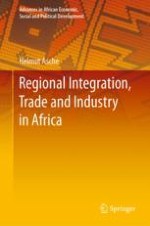2021 | OriginalPaper | Buchkapitel
2. The Logical Sequence of Regional Economic Integration
verfasst von : Prof. Helmut Asche
Erschienen in: Regional Integration, Trade and Industry in Africa
Aktivieren Sie unsere intelligente Suche, um passende Fachinhalte oder Patente zu finden.
Wählen Sie Textabschnitte aus um mit Künstlicher Intelligenz passenden Patente zu finden. powered by
Markieren Sie Textabschnitte, um KI-gestützt weitere passende Inhalte zu finden. powered by
